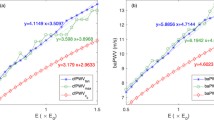Abstract
Arterial compliance (C) describes the ability of the arterial system to increase volume (V) with increasing pressure (P). Compliance is a marker of preclinical vascular diseases and cardiovascular risk factor. There are many different methods estimating arterial compliance. The aim of this study was to find out whether three of them: diastolic decay time method, pulse pressure method and area method are able to recover assumed value of C, when applied to reservoir-wave model of arterial system. This model assumes that arterial pressure is sum of two components: pressure caused by blood flow and pressure resulting from change in arterial blood volume. We calculate aortic blood pressure using reservoir-wave model for given blood flow and different values of model parameters Z—arterial impedance (0.1 < Z < 0.4) C—compliance (0.6 < C < 2.0), R—total peripheral resistance (0.5 < R < 3.0) Next, we use above mentioned three methods of compliance estimation and compared recovered value of C with value of C used in reservoir—wave model. We found, that area method showed best agreement between assumed and calculated arterial compliance C. Also diastolic decay time method can be used but estimated R may be misleading. Pulse pressure method produced erroneous estimates of assumed C values.
Access this chapter
Tax calculation will be finalised at checkout
Purchases are for personal use only
Similar content being viewed by others
References
Dart, Anthony M., and Bronwyn A. Kingwell. “Pulse pressure—a review of mechanisms and clinical relevance.” Journal of the American College of Cardiology 37.4 (2001): 975–984.
van der Giezen AM, Schopman-Geurts van Kessel JG, Schouten EG, Slotboom BJ, Kok FJ, Collette HJ. Systolic blood pressure and cardiovascular mortality among 13,740 Dutch women. Prev Med (1990); 19:456–465.
Domanski MJ, Mitchell GF, Norman JE, Exner DV, Pitt B, Pfeffer MA. Independent prognostic information provided by sphygmomanometrically determined pulse pressure and mean arterial pressure in patients with left ventricular dysfunction. J Am Coll Cardiol (1999); 33:951–958.
Tyberg, John V., et al. “The case for the reservoir-wave approach.” International journal of cardiology 172.2 (2014): 299–306.
Frank O. Die grundform des arteriellen pulses. Z Biol 1899; 37:483–526.
Wang J. J., O’Brien A. B., Shrive N. G., Parker K. H., Tyberg J. V. Time-domain representation of ventricular-arterial. Am J Physiol Heart Circ Physiol 2003; 284: H1358–H1368.
Stergiopulos, N., J-J. Meister, and N. Westerhof. “Simple and accurate way for estimating total and segmental arterial compliance: the pulse pressure method.” Annals of biomedical engineering 22.4 (1994): 392–397.
Liu, Zhaorong, Kenneth P. Brin, and F. C. Yin. “Estimation of total arterial compliance: an improved method and evaluation of current methods.” American Journal of Physiology-Heart and Circulatory Physiology 251.3 (1986): H588–H600.
Segers, Patrick, et al. “Pulse pressure method and the area method for the estimation of total arterial compliance in dogs: sensitivity to wave reflection intensity.” Annals of biomedical engineering 27.4 (1999): 480–485.
Author information
Authors and Affiliations
Corresponding author
Editor information
Editors and Affiliations
Ethics declarations
The authors declare that they have no conflict of interest.
Rights and permissions
Copyright information
© 2019 Springer Nature Singapore Pte Ltd.
About this paper
Cite this paper
Żyliński, M., Niewiadomski, W., Sadowiec, M., Cybulski, G. (2019). Different Methods of Arterial Compliance Estimation Tested with Reservoir-Wave Model of Arterial System. In: Lhotska, L., Sukupova, L., Lacković, I., Ibbott, G.S. (eds) World Congress on Medical Physics and Biomedical Engineering 2018. IFMBE Proceedings, vol 68/1. Springer, Singapore. https://doi.org/10.1007/978-981-10-9035-6_131
Download citation
DOI: https://doi.org/10.1007/978-981-10-9035-6_131
Published:
Publisher Name: Springer, Singapore
Print ISBN: 978-981-10-9034-9
Online ISBN: 978-981-10-9035-6
eBook Packages: EngineeringEngineering (R0)




